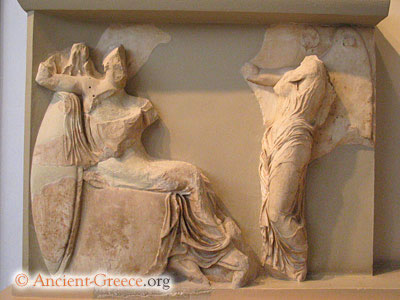The artistic expressions in the Greek world achieved remarkable development, reflecting the traditions and the main transformations that occurred in this society throughout antiquity.
Greek art is anthropocentric, concerned with realism, he sought to exalt human beauty, highlighting the perfection of its forms is still rational, reflecting on their observations concrete manifestations of the elements that surround the man.
To better understand the artistic expressions of the Greeks is necessary to recall the importance of religion and its manifestation in human life. The Greek religion gave great value to the gods at the same time it gave great value to men. Its culture is considered anthropocentric, individualistic, rational, yet hedonistic, allowing humans to perform work that reflect their inner feelings, producing pleasure, without being utilitarian.
Greek Architecture
The main manifestation of the architecture were the Greek temples. The fact that they are polytheists and believe in the resemblance between gods and men, has created a unique religious expression in the Greek World, and the temples of many different gods throughout all the Greek cities.
The temples were usually built on a platform three feet high called estereóbato.
Public buildings are also relevant and reflect the architectural transformations [policies experienced by the main Greek cities such as Athens.
The use of stone columns is a common feature of Greek architecture, being responsible for the appearance of monumental buildings.
At first the columns followed the two styles: Doric, the simpler and more "heavy", and the Ionian, considered "softer". In the fifth century came the Corinthian style, considerably more ornate, refined. It was in the fifth century, also known as the Golden Age or Age of Pericles, who met his greatest architecture development, but the great example the Parthenon in Athens, the architect Ictineo.
Greek Sculpture
Between the ninth and eleventh centuries BC sculpture produced small works, representing human figures in clay or ivory. During the Archaic period the stone has become the most used material, common in simple statues of boys (Kouros) and girls (Kores) and also reflected the influence abroad.
The height of the sculpture in the classical period occurred during the fifth century, when works have become more realistic, to reflect the perfection and beauty of human forms, and subsequently gained momentum.
Kouros,
Marble, 3m tall, circa 600 B.C.
Found in a pit at the temple of Poseidon at Sounio along with
Marble, 3m tall, circa 600 B.C.
Found in a pit at the temple of Poseidon at Sounio along with
parts of four other destroyed kouroi.
Aristodikos
Marble, circa 500 B.C.
1.95m tall
The name Aristodikos is carved at the statue's base.
This Kouros has short hair and the hands are not attached to the sides of the body.
Marble, circa 500 B.C.
1.95m tall
The name Aristodikos is carved at the statue's base.
This Kouros has short hair and the hands are not attached to the sides of the body.
The statue with its more rounded, less stylized characteristics, and with its light pose
(it is not as "stiff" as other kouroi,) represents a forward step in the development of art,
and prepares the ground for the eventual move towards classical sculpture.
Boy Jockey and Horse
Bronze, circa 220 BC.
Lifesize. Jockey 84cm (33") tall.
Bronze, circa 220 BC.
Lifesize. Jockey 84cm (33") tall.
Poseidon of Melos
Marble, circa 140 BC.
Marble, circa 140 BC.
Aphrodite of Melos
(Venus de Milo)
Marble circa 150 BC.
Height 2.04 m (6'8.5")
(Venus de Milo)
Marble circa 150 BC.
Height 2.04 m (6'8.5")
Two relief sculptures from the parapet of the temple of Athena Nike.
From the South side. Seated Athena and standing Nike. It is uncertain if
the two figures were originaly carved in association to each other.
From the South side. Seated Athena and standing Nike. It is uncertain if
the two figures were originaly carved in association to each other.
Marble, (Acropolis Museum)
The Doric style is rather sturdy and its top (the capital), is plain.
This style was used in mainland Greece and the colonies in southern
Italy and Sicily.
The Ionic style is thinner and more elegant. Its capital is decorated with a scroll-like
design (a volute). This style was found in eastern Greece and the islands.
The Corinthian style is seldom used in the Greek world, but often seen on Roman
temples. Its capital is very elaborate and decorated with acanthus leaves.
The Acropolis hill (acro - edge, polis - city), so called the "Sacred Rock" of Athens,
is the most important site of the city and constitutes one of the most recognizable monuments
of the world. It is the most significant reference point of ancient Greek culture, as well as the
symbol of the city of Athens itself as it represent the apogee of artistic development in the
5th century BC. During Perikles' Golden Age, ancient Greek civilization was represented in an
ideal way on the hill and some of the architectural masterpieces of the period were erected
on its ground.
TO SEE AN INTERACTIVE VERSION OF "THE ACROPOLIS OF ATHENS" CLICK ON THE FOLLOWING LINK:










No comments:
Post a Comment